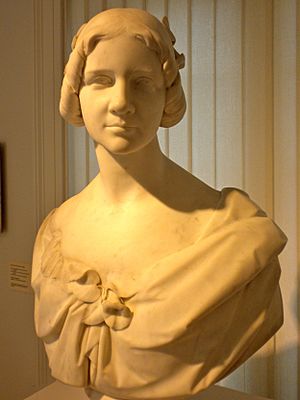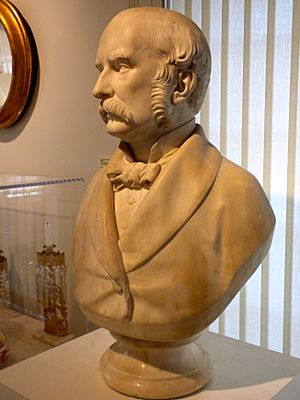American Swedish Historical Museum facts for kids
 |
|
| Established | 1926 |
|---|---|
| Location | Franklin Delano Roosevelt Park, Philadelphia, Pennsylvania, U.S. |
| Public transit access | |
The American Swedish Historical Museum is the oldest museum in the United States that celebrates Swedish-American history. You can find it in Franklin Delano Roosevelt Park in South Philadelphia. The land where the museum stands was originally given by Queen Christina of Sweden in the 1600s to settlers of New Sweden.
Contents
Museum History
How the Museum Started
In 1926, a group called the Swedish-American committee was formed. This group was part of the Sesqui-Centennial International Exposition. A famous writer and historian named Amandus Johnson led this committee. From this, a new group was created to remember the New Sweden colony, which began in 1638.
This new group was called the New Sweden Tricentennial Association. They wrote a history book called Swedes In America, 1638–1938. It was edited by Adolph B. Benson and Naboth Hedin.
Building the Museum
Soon after, a big effort began to build a Swedish Museum in Philadelphia. On June 2, 1926, Sweden's Crown Prince, Gustaf VI Adolf, helped lay the first stone for the museum. He later became King of Sweden.
In 1928, artist Christian von Schneidau painted beautiful murals on the ceiling and walls of the museum's entrance hall. The museum officially opened to the public on June 28, 1938. This special event was planned to celebrate 300 years since the Swedes first arrived on the shores of Delaware. Swedish Prince Bertil and Princess Louise were there for the dedication.
Museum Building Design
The museum's design is inspired by Ericsberg Castle, a grand house from the 1600s in Sweden. The architect, John Nydén, was a Swedish-American from Chicago. He mixed Swedish and American styles. For example, the outside arches look like those at Mount Vernon. The copper dome on top is a copy of the one on Stockholm City Hall.
The museum has 12 main rooms, called galleries. These galleries show a wide and interesting collection of history and culture.
Exploring the Galleries
Three of the museum's galleries focus on the history of the New Sweden Colony. This colony was started in the Delaware Valley in 1638. These rooms offer lots of information about this part of history, which many people don't know much about. Other galleries show more recent Swedish contributions. These range from Art Deco to International styles.
Museum Galleries

- Golden Map Room – This is the first of three rooms about New Sweden. It shows what Sweden was like in the 1600s.
- New Sweden Room – This room tells the story of life on the land where the museum now stands.
- The Stuga – "Stuga" means "little house" in Swedish. This room looks like the inside of a Swedish farmhouse from the 1800s.
- Nord Library – This is a research library. It has books and information about the history of New Sweden and Swedish people moving to America in the 1800s.
- Linnaeus-Kalm Room – This room is named after Carl Linnaeus and Peter Kalm, who were botanists (plant scientists) in the 1700s. It shows Swedish decorative art made of glass and features plants.
- Fredrika Bremer Room – This room celebrates the achievements of Swedish women. It is named after the Swedish writer Fredrika Bremer.
- Jenny Lind Room – This room is about the Swedish opera singer Jenny Lind. It shows how popular she was in America and how her fame lasted.
- Chicago Room – This room honors the work of Swedish-American architects and builders.
- John Ericsson Room – A mural on the wall shows John Ericsson presenting his design for the ironclad ship Monitor (USS Monitor) to Abraham Lincoln's War Cabinet.
- The Balcony – Here you can see paintings and sculptures by Swedish-American artists. There is also a selection of Swedish furniture.
- Changing Exhibit Gallery – This gallery changes its exhibits about two times a year.
Raoul Wallenberg Humanitarian Award
The American Swedish Historical Museum gives out the Spirit of Raoul Wallenberg Humanitarian Award. This award goes to a person, people, or group who have shown a strong commitment to helping others. They must have made a big difference to reduce human suffering or unfairness. Their actions must involve sacrifices or risks, and they must have done them without expecting a reward.
The award is named after Raoul Wallenberg. He was a Swedish diplomat who worked to save Hungarian Jews during World War II.
The Spirit of Raoul Wallenberg Award includes money and a special bowl from Orrefors, Sweden. This is given to the winner at a ceremony. Past winners include A. Leon Higginbotham for his work helping children and human rights in South Africa. Dr. William P. Magee, Jr. and Kathleen S. Magee won for starting Operation Smile. Per Anger was honored for working with Raoul Wallenberg to save Hungarian Jews during World War II. Reverend Dr. Haruun L. Ruun of Sudan received the award for his efforts to bring peace to his country.
See also
 In Spanish: American Swedish Historical Museum para niños
In Spanish: American Swedish Historical Museum para niños


